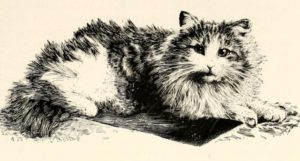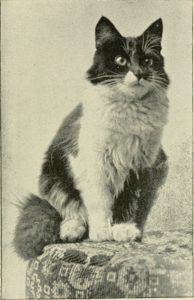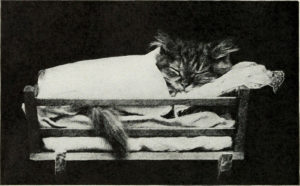LIS Journal Club, a new LIS research article reading group, is hosting a critlib-themed discussion! Their September article is “On Dark Continents and Digital Divides: Information Inequality and the Reproduction of Racial Otherness in Library and Information Studies” by Dave Hudson. Discussion includes asynchronous commenting via a web annotation tool (Hypothes.is) as well as a live Twitter chat on Thursday September 22. Find more information at lisjournalclub.tumblr.com and follow along on Twitter with #LISjc!
All posts by violet
Wikipedia & #critlib

64th chat, Tuesday August 23rd 2016: Wikipedia & #critlib
Moderated by @oksveta @fiiidget @nora_almeida
Storify (pdf, html) by @poorcharlotte
Suggested readings:
- McCook, K. D. L. P. (2014). Librarians as Wikipedians: From library history to “Librarianship and Human Rights” (pdf). Progressive Librarian, 42, 61-81.
Discussion questions:
- Q1. What is your stance towards/relationship with Wikipedia (WP) & what experiences have brought you to that stance? #critlib
- Q2. In what ways could Wikipedia be a potential resource or site for enacting #critlib?
- Q3. In what ways are the pillars (i.e. Neutral Point of View) and/or organizational structures of WP in tension with #critlib? http://bit.ly/2b3HO7d [link to Wikipedia page for the 5 pillars]
- Q4. Do librarians have a responsibility to address pitfalls of WP like gender/race/identity gaps? #critlib
- Q5. What accounts for historic maligning of WP by libs and what does this tell us about our own stance towards information? #critlib
For further exploration:
- Pinboard on Wikipedia and social justice compiled by @LibSkrat
- Fact factories: Wikipedia and the power to represent (dissertation, pdf) by @hfordsa
ethics of digitization

63rd chat, Monday August 8th 2016: ethics of digitization
Moderated by @tararobertson and @zinelib
Storify (pdf, html) by @tararobertson
Suggested readings:
- Digitization: just because you can, it doesn’t mean you should
- “Moko; or Maori Tattooing” Project: a report on consultation
- Zine Librarians Code of Ethics
Discussion questions:
- Q1 What are pros & cons of make digitization decisions informed by personal & community ethics, in addition to/instead of The Law? #critlib
- Q2 When making digitization decisions, how do we balance the needs of (living) subjects & (future) scholars, now vs. 100s from now? #critlib
- Q3 What are some #critlib models of providing community/research access to a collection, vs. protecting privacy?
- Q4 How should #critlib digitization decisions differ with regard to race, gender, sexuality, disability, etc. vs. those of default identities?
- Q5 How should #critlib digitization decisions differ with regard to porn vs. other content like newspapers, books, or historical photos?
“offensive” items in the collection

62nd chat, Tuesday July 26th 2016: “offensive” items in the collection
6pm Pacific / 7pm Mountain / 8pm Central / 9pm Eastern
Moderated by @zoh_zoh
Storify (pdf, html) by @violetbfox
Suggested readings:
- Emily Knox, “The Books Will Still Be in the Library”: Narrow Definitions of Censorship in the Discourse of Challengers. From Library Trends, volume 62, number 4, Spring 2014
- Alison Leigh Cowan, A Library’s Approach to Books That Offend. From The New York Times, August 19 2009
- ALA’s Diversity in Collection Development: An Interpretation of the Library Bill of Rights (last amended July 2014)
Discussion questions:
- Q1. What kinds of materials in your library have offended your users?
- Q2. What kinds of materials in your library have you & your staff found offensive?
- Q3. Is it censorship to relocate/reclassify items?
- Q4. How do you empower your users to be directly involved in collection development and maintenance?
Twitter chats calendar
value sensitive design

61st chat, Tuesday July 19th 2016: value sensitive design
Moderated by @metageeky
Storify (pdf, html) by @violetbfox
In multiple discussions, twitter chats, and conference presentations, the need for library work to understand, respect, and address issues of diversity is continually brought up. We talk about the need to not only re-design our cataloging methods but also questioning the underlying technology that drives discovery. This requires navigating, balancing, and integrating diverse aspects of academics, society, and technology. Value sensitive design (VSD) is one design approach to consider for tackling these challenges. VSD emphasizes identifying and respecting human values throughout the interactions of society and technology. Using a multidisciplinary perspective that draws on philosophy, social sciences, and engineering, VSD has been applied to many domains, including city planning, assistive technologies, and Internet privacy policies. Let’s explore its potential for innovation and progress in library work, especially in regards to critical librarianship.
Suggested readings:
- Deibel, K. Value Sensitive Design: slideshow from January 2016 Mashcat presentation (pptx)
- Friedman, B., Kahn Jr., P., and Borning, A. Value Sensitive Design and information systems (2006)
- Friedman, B. and Kahn Jr., P. Human values, ethics, and design (2003)
Discussion questions:
- Q1. How would you define Value Sensitive Design?
- Q2. What are some explicitly-supported values in library work?
- Q2b. In VSD, designers need to recognize if there are any values they explicitly support. Are there explicitly-supported values in #critlib work?
- Q3. How can VSD be applied to #critlib? What areas of library work could VSD and #critlib benefit?
- Q4. What might be some challenges in applying VSD to library work? How could those challenges be overcome?
Additional resources:
- one of the fundamental influencing papers: Latour, B. Where are the missing masses? The sociology of a few mundane artifacts (1992)
- example of Habermass being used in VSD: Borning, A., Friedman, B., Davis, J., and Lin, P. Informing public deliberation: Value sensitive design of indicators for a large-scale urban simulation (2005)
- @metageeky‘s thesis: Deibel, K. Understanding and supporting the adoption of assistive technologies by adults with reading disabilities (2011)
- list of VSD papers: Value Sensitive Designs publications
join the #critcat Slack
Interested in critlib-inspired discussions of cataloging & metadata issues in a social justice context? Join the critcat Slack group, where there’ll be discussions and collaborations to enact change. To receive an invitation to the group, enter your email at critlib.org/critcat.
caregiving

60th chat, Monday July 11th 2016: caregiving
11am Pacific / noon Mountain / 1pm Central / 2pm Eastern
Moderated by @sarahcrissinger & @ibeilin
Storify (pdf, html) by @nishamody
Suggested readings:
- “Eldercare: The Forgotten Feminist Issue” by Jamie Nesbitt Golden (2014)
Discussion questions:
- Q1. How do you define “care”? We often talk about caregiving in terms of parenthood, but what are other forms of caregiving? #critlib
- Q2. How do social expectations (or a lack of such expectations) for caregiving affect you or your workplace? #critlib
- Q3. What are some of the structural, policy-level impediments one might encounter as a caregiver in LIS? #critlib
- Q4. We often see a disparity in benefits between staff in different roles, e.g. professional, support, faculty. Is this true in your work? #critlib
- Q5. If you have benefits others don’t, how can you work to create more inclusive policies around caregiving? #critlib
Additional resources:
- ALA’s Caregiver’s Toolkit (2011)
- “Quantify Everything: A Dream of a Feminist Data Future” by Amelia Abreu (2014)
digital preservation

59th chat, Monday June 6th 2016: digital preservation
Moderated by @dinahhandel
Storify (pdf, html) by @dinahhandel
Discussion questions:
- Q1 How do you define digital preservation? Does your definition differ from established digital preservation concepts? How & why? #critlib
- Q2 Are digi-pres concepts inadequate for archives? How can we bridge the gap between recommended best practices & digi-pres labor? #critlib
- Q3 What sustainability challenges- environmental, financial- does digi-pres present? How can digi-pres be more sustainable? #critlib
- Q4 In what ways do you see power, oppression, or social justice intersect with digital preservation? #critlib
- Q5 What are your hopes for the field of digital preservation going forward? #critlib
Additional resources:
No need to read any or all of these- just a list of works that give an overview of the field and some of the primary concepts and concerns…
- Bailey, Jefferson. “I review six digital preservation models so you don’t have to” http://www.jeffersonbailey.com/i-review-6-digital-preservation-models-so-you-dont-have-to/
- Digital POWRR, Digital Preservation 101 http://digitalpowrr.niu.edu/digital-preservation-101/
- Egger, Alexander. “Shortcomings of the Reference Model for an Open Archival Information System” http://www.ieee-tcdl.org/Bulletin/v2n2/egger/egger.html
- Lavoie, Brian. The Open Archival Information System Reference Model: Introductory Guide. DPC Technology Watch Series Report 04-01. Digital Preservation Coalition (UK): January 2004. http://www.dpconline.org/component/docman/doc_download/91-introduction-to-oais (pdf)
- LeFurgy, Bill. Lifecycle Models for Digital Stewardship. (Feb. 21, 2012). http://blogs.loc.gov/digitalpreservation/2012/02/life-cycle-models-for-digital–stewardship/
- Lyons, Bertram “There will be no Digital Dark Age” https://issuesandadvocacy.wordpress.com/2016/05/11/there-will-be-no-digital-dark-age/
- National Digital Stewardship Alliance Levels of Digital Preservation: An Explanation and Uses http://www.digitalpreservation.gov/documents/NDSA_Levels_Archiving_2013.pdf (pdf)
- National Agenda for Digital Stewardship: Executive Summary, 2014 http://ndsa.org/documents/2014ExecutiveSummary.pdf (pdf)
- National Digital Stewardship Alliance, Digital Preservation in a Box: Digital Preservation 101 https://wiki.diglib.org/NDSA:Digital_Preservation_in_a_Box#Digital_Preservation_101
- Project ARCC: Archivists Responding to Climate Change https://projectarcc.org/
- Shira Peltzman and Alice Prael, “Can’t wait for Perfect: Implementing Good Enough Digital Preservation” code4lib presentation (video at https://youtu.be/Dd04w–7EuY?t=1h22m2s)
- Reference Model for an Open Archival Information System (OAIS) http://public.ccsds.org/publications/archive/650x0m2.pdf (pdf)
- Rice, Dave. “FLAC in the archives” http://dericed.com/tag/flac/
- Rosenthal, David. http://blog.dshr.org/ In particular the following posts: http://blog.dshr.org/2013/08/more-on-storing-all-that-stuff.html, http://blog.dshr.org/2013/07/immortal-media.html, http://blog.dshr.org/2013/02/rothenberg-still-wrong.html (this post pushes back at some ideas proposed by Rothenberg following his 1998 CLIR report)
- Rothenberg, Jeff. Avoiding Technological Quicksand: Finding a Viable Technical Foundation for Digital Preservation. (January 1998) http://www.clir.org/pubs/reports/rothenberg/contents.html
- Schumacher, Jaime, et al. “From Theory to Action: Good Enough Digital Preservation for Under-Resourced Cultural Heritage Institutions.” Digital POWRR White Paper for the Institute of Museum and Library Services. 27 August 2014. http://commons.lib.niu.edu/handle/10843/13610
- Tansey, Eira “Institutional Silences and the Digital Dark Age” https://issuesandadvocacy.wordpress.com/2016/05/23/institutional-silences-and-the-digital-dark-age/
- Tansey, Eira. 2016. Archival adaptation to climate change. Sustainability: Science, Practice, & Policy 11(2) Published online Mar 02, 2016. http://sspp.proquest.com/archives/vol11iss2/1509-019.tansey.html
- Owens, Trevor. “Digital Preservation’s Place in the Digital Humanities” http://www.trevorowens.org/2014/03/digital-preservations-place-in-the-future-of-the-digital-humanities/
visual culture/literacy
![From Mammals of other lands / Charles J. Cornish [and others], editors (1917)](http://critlib.org/wp-content/uploads/2016/05/58-orangetabby-300x269.jpg)
Moderated by @AcornElectric
Storify (pdf, html) by @ArchivistAriel
This chat will help us define visual literacy within our contexts and look at the ways critical librarianship can address the unique way visual information can impact and influence critical perspectives on the culture we live in. From signage in the library to image use and creation in academia visual information wields significant power in our spaces. We’ll discuss how we teach ourselves how to identify critical issues in visual culture, how we raise awareness of these issues, and how we teach visual literacy alongside information literacy.
If you’re unfamiliar with visual literacy feel free to check out the ACRL visual literacy standards and the Hattwig et al. article below about the standards.
Suggested readings:
- Henrich, K. (2014, May 27). Visual Literacy for Librarians: Learning Skills and Promoting Best Practices.
- “ACRL Visual Literacy Competency Standards for Higher Education”, American Library Association, October 27, 2011.
- Hattwig, D., Bussert, K., Medaille, A., & Burgess, J. (2013). Visual Literacy Standards in Higher Education: New Opportunities for Libraries and Student Learning. Portal: Libraries and the Academy, 13(1), 61–89.
Discussion questions:
- Q1. How do you define visual literacy and how does visual lit impact and influence our library spaces, intellectually/physically? #critlib
- Q2. What are some critical issues related to visual info and how can #critlib raise awareness of these issues? #critlib
- Q3. How have you learned of critical issues w/in visual culture/how do you share visual lit-related skills/concepts with colleagues? #critlib
- Q4. How do you teach or address specific visual literacy concepts/issues within your community and library? #critlib (For example, critiquing persuasive or manipulative strategies in image production, meaning, message, cultural and historical factors relevant to production of image.)
For further exploration:
- How Do You Look: Promoting Visual Literacy at Duke University and Beyond. From the Nasher Museum of Art at Duke University in cooperation with Duke Libraries.
- The Visual Literacy Toobox: Learning to Read Images. From the College of Arts & Humanities, University of Maryland College Park.
- Visual Literacy LibGuide. From the Boston University Libraries.